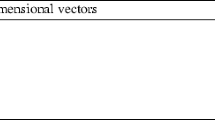Abstract
Quaternions, although not well known, provide a solid base to describe orientation of an object or a vector. They are efficient and well suited to solve rotation and orientation problems in computer graphics and animation. This paper describes a new method for splining quaternions so that they can be used with keyframe animation. We also show that quaternions, although up to now solely used for animation purposes, can be used succesfully in the field of modelling and rendering and we prove that we can construct a significantly faster rendering algorithm with the use of quaternions.
Access this chapter
Tax calculation will be finalised at checkout
Purchases are for personal use only
Preview
Unable to display preview. Download preview PDF.
Similar content being viewed by others
References
Blake E.H. “A metric for Computing Adaptive Detail in Animated Scenes using Object Oriented Programming” Proc. Eurographics 87, pp. 295–307
Boehm W.et al.“A survey of curve and surface methods in CAGD” Computer Aided Geometric Design 1 (1984), pp. 1–60
Catmull E. & Rom R. “A Class of Local Interpolating Splines” Computer Aided Geometric Design, pp. 317–326,1974
Cayley A.“On certain results relating to quaternions” Philosophical Magazine xxvi, pp. 141–145, Feb. 1845
Clark J.“Parametric Curves, Surfaces and Volumes in Computer Graphics and Computer-Aided Geometric Design”, Techn. Rep. 221, Computer Systems Laboratory, Stanford Univ., Palo Alto, California, nov. 1981
Duff T.“Splines in Animation and Modelling” Siggraph 86 Course #15: “State of the Art in Image Synthesis”
Earnshaw R.A.“The mathematics of computer graphics” The Visual Computer (1987) 3, pp. 115–124
Foley J.D. & Van Dam A.“Fundamentals of Interactive Computer Graphics” Addison Wesley, 1984
Hankins T.L.“Sir William Rowan Hamilton” The John Hopkins University Press, 1980
Magnenat-Thalmann N. & Thalmann D. “Area, spline-based and structural models for generating and animating 3D characters and logos” The Visual Computer (1985) 1, pp. 15–23
Pletinckx D. “The use of spline subdivision in computer animation and digital painting” Barco Industries Creative Systems technical memo #TM.03DEC87.DP
Shoemake K. “Animating Rotation with Quaternion Curves” Computer Graphics, 19(3), pp. 245–254, Proc. Siggraph 85
Shoemake K. “Quaternion Calculus and Fast Animation” Siggraph 87 Course # 10: “Computer Animation: 3D Motion specification and control”, pp. 101–121
Author information
Authors and Affiliations
Editor information
Editors and Affiliations
Rights and permissions
Copyright information
© 1988 Springer-Verlag Berlin Heidelberg
About this paper
Cite this paper
Pletincks, D. (1988). The Use of Quaternions for Animation, Modelling and Rendering. In: Magnenat-Thalmann, N., Thalmann, D. (eds) New Trends in Computer Graphics. Springer, Berlin, Heidelberg. https://doi.org/10.1007/978-3-642-83492-9_4
Download citation
DOI: https://doi.org/10.1007/978-3-642-83492-9_4
Publisher Name: Springer, Berlin, Heidelberg
Print ISBN: 978-3-642-83494-3
Online ISBN: 978-3-642-83492-9
eBook Packages: Springer Book Archive




